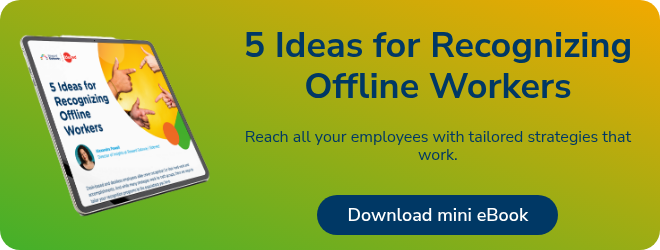Are you overlooking a vital part of your workforce?
Desk-based and deskless employees alike thrive on recognition, and acknowledging these diverse groups requires a tailored approach. Today, let's explore some ways to recognize those who don’t always sit behind a desk – and why it’s crucial for your organization’s success.
All employees – on- or offline, stationary or mobile – crave three things:
- Purpose– Understanding how their role impacts the team
- Recognition – Feeling valued for their contributions
- Belonging – Building connections with their boss and teammates
To boost engagement, your recognition initiatives should contribute positively to your culture while being inclusive and timely for everyone. Whether your organization is predominantly offline or has only a few non-desk-based roles, try out these five strategies to boost recognition engagement.
5 ways to boost offline worker recognition
1. Set up central recognition spots
 For online employees, accessing the recognition program is as simple as opening a new browser tab. But offline workers can be anywhere, with limited access to technology or few opportunities to check in.
For online employees, accessing the recognition program is as simple as opening a new browser tab. But offline workers can be anywhere, with limited access to technology or few opportunities to check in.
For non-office workplaces, install central connection hubs in employee shared spaces (like the break room, for example). A good rule of thumb is at least one kiosk per location, or per 100 employees – and some helpful posters will help guide employees to recognize each other for hard work and successes.
2. Get managers involved
One of the top five things employees said they wanted from managers in our Workplace Wellbeing in 2025 report was more recognition for their efforts – and this applies to online and offline employees alike. Managers are your frontline defense against disengagement and attrition, so ensure that your managers are equipped to demonstrate the processes to their teams. Additionally, set aside time in the schedule for managers to take groups of employees away from their tasks to walk them through not only how to use the technology, but also what it’s for.
Pro tip: Practicing recognition gets easier with examples, practice and opportunity. Have managers build a few minutes into meeting agendas for recognition opportunities – whether someone went above and beyond for a customer, solved a problem single-handedly or simply completed an important task, this is the perfect time to call out the behaviors we want to encourage among our teams.
3. Cultivate some recognition champions
 Recognition champions are employees and managers throughout your company that really understand the value of recognition and are willing to be a cheerleader for others to encourage take-up and usage.
Recognition champions are employees and managers throughout your company that really understand the value of recognition and are willing to be a cheerleader for others to encourage take-up and usage.
Train them to share best practices and support colleagues, especially those hesitant about using technology. Regular meetings focused on recognition can help these champions foster a culture of appreciation and inclusion that spreads throughout the entire organization.
4. Embrace mobile technology
Smartphones are everywhere, and your offline workers can greatly benefit from that. A dedicated employee engagement app – like Connect+ – can connect recognition activities and communications no matter where an employee is located or what time of day (or night!) they happen to be available.
Encourage everyone to download the app to view and send recognition moments, and remind managers and employees to turn on notification alerts for real-time acknowledgment.
5. Make recognition more strategic
Strategic recognition, or “AVI” recognition, highlights specific achievements tied to your organization’s values. Follow these three steps:
- Action: Share the story so it’s clear what this person has done.
- Value: Connect the action in question to one of your organizational values or the mission.
- Impact: Emphasize the benefits of the action across teams.
With a little effort, your “thank you” can evolve into a message that resonates deeply with the entire organization.
Ready to explore these ideas more in depth?
Download our free mini eBook, packed with insights to help you optimize your recognition strategies. Get your free copy and start making a difference today.
No recognition program yet? Reach out to one of our friendly employee experience experts today and let us help you make your corner of the world a better place to work.

 (1).jpeg) Alexandra Powell
Alexandra Powell


